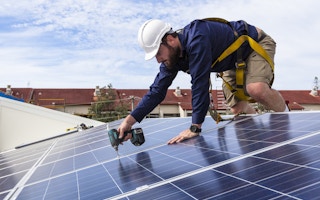Improving energy efficiency creates far more jobs than generating it, and at the same time provides a way out of the Covid crisis by bringing prosperity.
That’s the verdict of a report by the International Energy Agency (IEA), which says efficiency-related stimulus packages that have been announced already will create 1.8 million jobs in the next two years, with many more to come if governments spend their money wisely.
Two-thirds of the jobs would be in the building sector, most of them in retrofitting homes, factories and offices with insulation and other efficiency measures.
One of the main benefits of the scheme, the IEA says, would be for young people with few academic qualifications, currently the worst hit by unemployment, who would be needed for most of the building jobs.
The remaining jobs would be in transport (20 per cent) and industry (16 per cent).
Based on information received by the IEA by December, when the report was published, 80 per cent of these new jobs would be created in Europe.
At the time the US was the largest employer of workers in energy efficiency, despite the anti-climate policies of the Trump administration.
With Joe Biden now occupying the presidency and rejoining the Paris Agreement, jobs in energy efficiency in the US are expected to snowball.
“
Energy efficiency investments are one of the most attractive investments in the energy sector for governments seeking to protect existing or generate new jobs.
International Energy Agency (IEA)
Altogether the scope for jobs in the sector across the world is enormous, with the developing world yet to take energy efficiency seriously.
Before the pandemic hit, the IEA estimated that there were 2.4 million energy efficiency jobs in the US, up to 3 million in Europe, but fewer than 750,000 in China and a maximum of 62,000 in Brazil.
With China now taking climate change far more seriously and pledging to be carbon neutral by 2060, energy efficiency is likely to create a boom for building workers there.
Although many building jobs have been lost because of Covid-19, the IEA estimates that the labour-intensive nature of many energy efficiency upgrades means spending US$1million on improving efficiency will generate between six and 15 jobs on average, depending on the sector.
Investments announced to date have created 3.4 million new job years (one job for one year) in the sector.
The report says: “As energy efficiency investments can also be mobilised quickly, they are one of the most attractive investments in the energy sector for governments seeking to protect existing jobs or generate new jobs during the recession.”
Best for new jobs
As part of their public relations drives when suggesting potentially unpopular new developments, most energy industries stress how many jobs will result.
For example, building a nuclear power station in the UK, Sizewell C, is said by the would-be builders to promise the creation of more than 5,000 jobs.
However, figures compiled by the UK Office for National Statistics show that energy efficiency trumps all other energy industries for job creation.
In the UK’s low-carbon and renewables energy sector, which includes all nuclear and renewable energy options, energy efficiency formed easily the largest component of jobs, with 114,000 full-time employees (51 per cent) in 2018.
There were 49,800 people employed in renewable activity, wind and solar for example, and only 12,400 in the whole nuclear energy sector, most of them in reprocessing spent fuel.
As the IEA notes, scaled-up worldwide there are potentially millions of jobs in energy efficiency, and it is clearly the single quickest and cheapest way of reducing carbon emissions, since it both reduces existing demand for energy and makes new fossil fuel power stations unnecessary.
This story was published with permission from Climate News Network.










